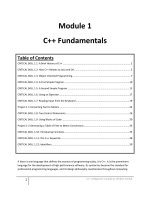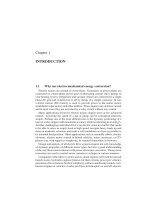Chapter 1 networking fundamentals
Bạn đang xem bản rút gọn của tài liệu. Xem và tải ngay bản đầy đủ của tài liệu tại đây (6.87 MB, 103 trang )
03/02/2020
Lecturer: Nguyễn Thị Thanh Vân – FIT - HCMUTE
History of computer network
Computer network
Network topology
Network protocol
Network Components
Internet
Packet-Switched Networks problems:
o Delay, Loss, and Throughput in
Protocol Layers and Their Service Models
OSI model
TCP/IP model
03/02/2020
2
1
03/02/2020
1960’s – “How can we transmit bits across a
communication medium efficiently and reliably?”
1970’s – “How can we transmit packets across a
communication medium efficiently and reliably?”
1980’s – “How can we provide communication services
across a series of interconnected networks?
1990’s – “How can we provide high-speed, broadband
communication services to support high-performance
computing and multimedia applications across the globe?”
2000's – What do you think will dominate in the next 10
years?
03/02/2020
3
2
Sender
Input
Information
m
Input
Device
3
Input data g
or signal
g(t)
Transmitter
Source System
03/02/2020
Transmitted
signal
s(t)
4
5
Received
signal
r(t)
Output data g’
or signal
g’(t)
’
Transmission
medium
Receiver
6
Output
Device
Output
Information
m’
Receiver
1
Destination System
4
2
03/02/2020
Data encoding
Signal generation: electro-magnetic signals to be transmitted over a
transmission medium
Synchronization: timing of signals between the transmitter and receiver
Error detection and correction: ensuring that transmission errors are
detected and corrected
Flow control: ensuring that the source does not overwhelm the
destination by sending data faster than the receiver can handle
Multiplexing: make more efficient use of a transmission facility. This
technique is used at different levels of communication
Addressing: indicating the identity of the intended destination
Routing: selecting appropriate paths for data being transmitted
Message formatting: conforming to the appropriate format
Security: ensuring secure message transmission
Systems management
03/02/2020
5
A
communication network is a collection of devices connected by some
communications media and Network Architecture (topology and protocol)
o Example devices are:
•
mainframes, minicomputers, supercomputers
•
workstations, personal computers
•
printers, disk servers, robots
•
X-terminals
•
Gateways, switches, routers, bridges
•
Cellular phone, Pager, TRS
•
Refrigerator, Television, Video Tape Recorder
o Communications Media
• twisted pairs, coaxial cables, fiber optics
• line-of-sight transmission: lasers, infra-red, microwave, radio
• satellite links
• Power line
03/02/2020
6
3
03/02/2020
Computer Communication – the exchange of information
between computers for the purpose of cooperative action
Computer Network – a collection of computers
interconnected via a communication network
03/02/2020
Transportation Network
Vehicles/People
Street address
Intersection
Street, highway, path
Traffic jam
Stop and go traffic light
Taking alternative path
Collision
HOV lane
Following a route to school
…
7
Computer Network
Packets/Payload
IP address
Bridge/router
Link/broadband/path
Network congestion
Flow control
Alternative route
Collision of packets
Flow Priority
Routing algorithm
…
8
4
03/02/2020
Resource Sharing
o Hardware (computing resources, disks, printers)
o Software (application software)
Information Sharing
o Easy accessibility from anywhere (files, databases)
o Search Capability (WWW)
Communication
o Email
o Message broadcast
Remote computing
Distributed processing (GRID Computing)
03/02/2020
9
History of computer network
Computer network
Network topology
Network protocol
Network Components
Internet
Packet-Switched Networks problems:
o Delay, Loss, and Throughput in
Protocol Layers and Their Service Models
OSI model
TCP/IP model
03/02/2020
10
5
03/02/2020
The network topology defines the way in which devices are
connected.
03/02/2020
11
All networked nodes are interconnected, peer to peer, using
a single, open-ended cable
Both ends of the bus must be terminated with a terminating
resistor to prevent signal bounce
03/02/2020
12
6
03/02/2020
Advantage:
o Easy to implement and extend
o Well suited for temporary networks that must be set up in a hurry
o Typically the least cheapest topology to implement
o Failure of one station does not affect others
Disadvantage
o Difficult to administer/troubleshoot
o Limited cable length and number of stations
o A cable break can disable the entire network; no redundancy
o Maintenance costs may be higher in the long run
o Performance degrades as additional computers are added
03/02/2020
13
A frame travels around the ring, stopping at each node. If a
node wants to transmit data, it adds the data as well as the
destination address to the frame.
The frame then continues around the ring until it finds the
destination node, which takes the data out of the frame.
o Single ring – All the devices on the network share a single cable
o Dual ring – The dual ring topology allows data to be sent in both
directions.
03/02/2020
14
7
03/02/2020
Advantage
o This type of network topology is very organized
o Performance is better than that of Bus topology
o No need for network server to control the connectivity between
workstations
o Additional components do not affect the performance of network
o Each computer has equal access to resources
Disadvantage:
o Each packet of data must pass through all the computers between
source and destination, slower than star topology
o If one workstation or port goes down, the entire network gets affected
o Network is highly dependent on the wire which connects different
components
03/02/2020
15
Have connections to networked devices that “radiate” out
form a common point
Each device can access the media independently
Have become the dominant topology type in contemporary
LANs (replace buses and rings)
Extended start
03/02/2020
16
8
03/02/2020
Advantage:
o Compare to bus: gives far much better performance
o Easy to connect new nodes or devices
o Centralized management.
o Failure of one node or link doesn’t affect the rest of network
Disadvantage:
o If central device fails whole network goes down
o The use of hub, a router or a switch as central device increases the
overall cost of the network
o Performance and as well number of nodes which can be added in
such topology is depended on capacity of central device
03/02/2020
17
Partial Mesh Topology :
o In this topology some of the systems are connected in the same
fashion as mesh topology but some devices are only connected to
two or three devices.
Full Mesh Topology :
o Each and every nodes or devices are connected to each
03/02/2020
18
9
03/02/2020
Advantages
o Each connection can carry its own data load.
o It is robust.
o Fault is diagnosed easily.
o Provides security and privacy.
Disadvantages:
o Installation and configuration is difficult.
o Cabling cost is more.
o Bulk wiring is required.
03/02/2020
19
Many different types of topologies which is a mixture of two
or more topologies.
03/02/2020
20
10
03/02/2020
A protocol defines the format and the order of messages
exchanged between two or more communicating entities, as
well as the actions taken on the transmission and/or receipt
of a message or other event
03/02/2020
21
Physical Media
o Cable,
Interconnecting Devices
o Router, switch, hub…
Computers
o Server, client
Networking Software
o Protocol, Network OS
Applications
o Mail, web….
03/02/2020
22
11
03/02/2020
Depending on the size and range of the computer network,
you can differentiate between different network
dimensions.
The most important network types include:
o Personal Area Networks (PAN): modern devices are integrated into a
o
o
o
o
network
Local Area Networks (LAN): more than 1 computer is to be connected
Metropolitan Area Networks (MAN): connects several LAN
Wide Area Networks (WAN): extend MAN across large geographic
areas, such as countries or continents
Global Area Networks (GAN): Internet
03/02/2020
23
History of computer network
Computer network
Network topology
Network protocol
Network Components
Internet
Packet-Switched Networks problems:
o Delay, Loss, and Throughput in
Protocol Layers and Their Service Models
OSI model
TCP/IP model
03/02/2020
24
12
03/02/2020
Introduction to Internet
The Network Edge
The Network core
o Switching Techniques: Circuit and Packet
03/02/2020
25
26
13
03/02/2020
1961–1972: Early packet-switching principles
1961: Kleinrock – queueing
theory shows effectiveness
of packet-switching
1964: Baran – packetswitching in military nets
1967: ARPAnet conceived by
Advanced Research Projects
Agency
1969: First ARPAnet node
operational
1972:
o ARPAnet demonstrated
publicly
o NCP (Network Control
Protocol) first host-host
protocol
o First e-mail program
o ARPAnet has 15 nodes
27
1972–1980: Internetworking, new and proprietary nets
1970: ALOHAnet satellite
network in Hawaii
1973: Metcalfe’s PhD thesis
proposes Ethernet
1974: Cerf and Kahn architecture for interconnecting
networks
late 70s: Proprietary
architectures: DECnet, SNA,
XNA
late 70s: Switching fixed length
packets (ATM precursor)
1979: ARPAnet has 200 nodes
Cerf and Kahn’s internetworking
principles:
o Minimalism, autonomy - no
internal changes required to
interconnect networks
o Best effort service model
o Stateless routers
o Decentralized control
Define today’s Internet
architecture
28
14
03/02/2020
1980–1990: New protocols, a proliferation of networks
1983: Deployment of TCP/IP
1982: SMTP e-mail protocol
defined
1983: DNS defined for
name-to-IP-address
translation
1985: FTP protocol defined
1988: TCP congestion
control
New national networks:
Csnet, BITnet, NSFnet,
Minitel
100,000 hosts connected
to confederation of
networks
29
1990s: Commercialization, the WWW
Early 1990’s: ARPAnet
decommissioned
1991: NSF lifts restrictions on
commercial use of NSFnet
(decommissioned, 1995)
Early 1990s: WWW
o hypertext [Bush 1945, Nelson
1960s]
o HTML, http: Berners-Lee
o 1994: Mosaic, later Netscape
o Late 1990s:
commercialization of the
WWW
Late 1990’s:
Est. 50 million computers
on Internet
Est. 100 million+ users
Backbone links running
at 1 Gbps
30
15
03/02/2020
Scale
How
to manage such a large system,
growing rapidly and uncontrollably,
consisting of heterogeneous devices,
managed by multiple entities
having limited resources
Let’s
take things one at a time
31
03/02/2020
32
16
03/02/2020
03/02/2020
33
03/02/2020
34
17
03/02/2020
03/02/2020
35
36
18
03/02/2020
37
38
19
03/02/2020
PC
o
Server
o
of connected devices:
Hosts = end systems
Running network apps
Wireless
laptop
Communication links
Smartphone
– Fiber, copper, radio,
satellite
– Transmission rate:
Wireless
bandwidth
links
•
Wired
links
•
Router
Mobile network
Millions
Global ISP
Home
network
Regional ISP
Enterprise
network
Packet switches: forward packets
(chunks of data)
– Routers and switches
03/02/2020
39
Devices connected to the Internet are often referred to as
end systems.
End systems are also referred to as hosts because they
host (that is, run) application programs
They are referred to as end systems because they sit at the
edge of the Internet,
03/02/2020
40
20
03/02/2020
Network:
o Mobile
o Home
o Enterprise
03/02/2020
41
The network that
physically connects an
end system to the first
(edge router) on a path
from the end system to
any other distant end
system
03/02/2020
42
21
03/02/2020
Home Access: DSL, Cable, FTTH, Dial-Up, Satellite
DSL
FTTH
03/02/2020
43
Access in the Enterprise (and the Home): Ethernet and WiFi
Ethernet
03/02/2020
44
22
03/02/2020
Access in the Enterprise (and the Home): Ethernet and WiFi
03/02/2020
45
the mesh of packet switches and links that interconnects the
Internet’s end systems
03/02/2020
46
23
03/02/2020
Network Structure 1
o interconnects all of the access ISPs with a single global transit ISP - a
network of routers and communication links that not only spans the
globe, but also has at least one router near each of the hundreds of
thousands of access ISPs
Network Structure 2,
o consists of the hundreds of thousands of access ISPs and multiple global
transit ISPs (the top tier and access ISPs at the bottom tier)
Network Structure 3
o multi-tier hierarchy – Internet
o Add more points of presence (PoPs) - group of routers in the provider’s
network
Network Structure 4
o ISPs, regional ISPs, tier-1 ISPs, PoPs, multi-homing, peering, and IXPs
Network Structure 5
o Network Structure 4 by adding content provider networks
03/02/2020
47
03/02/2020
48
24
03/02/2020
The switching technique will decide the best route for data
transmission.
03/02/2020
Circuit Switching
49
Packet Switching
Message Switching
03/02/2020
50
25









